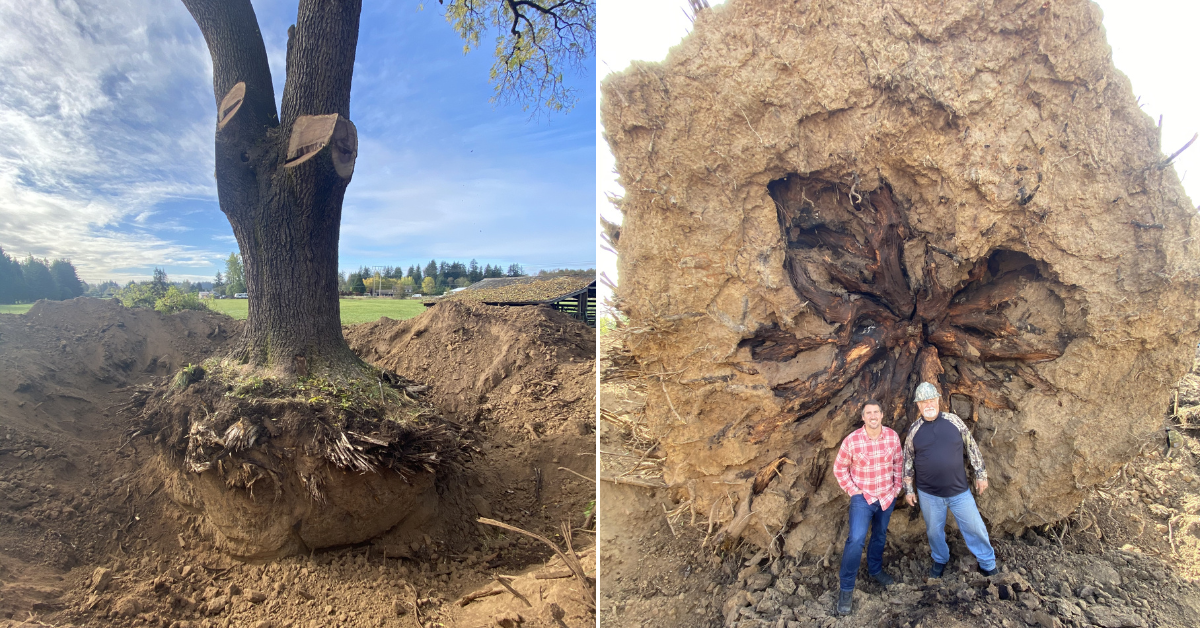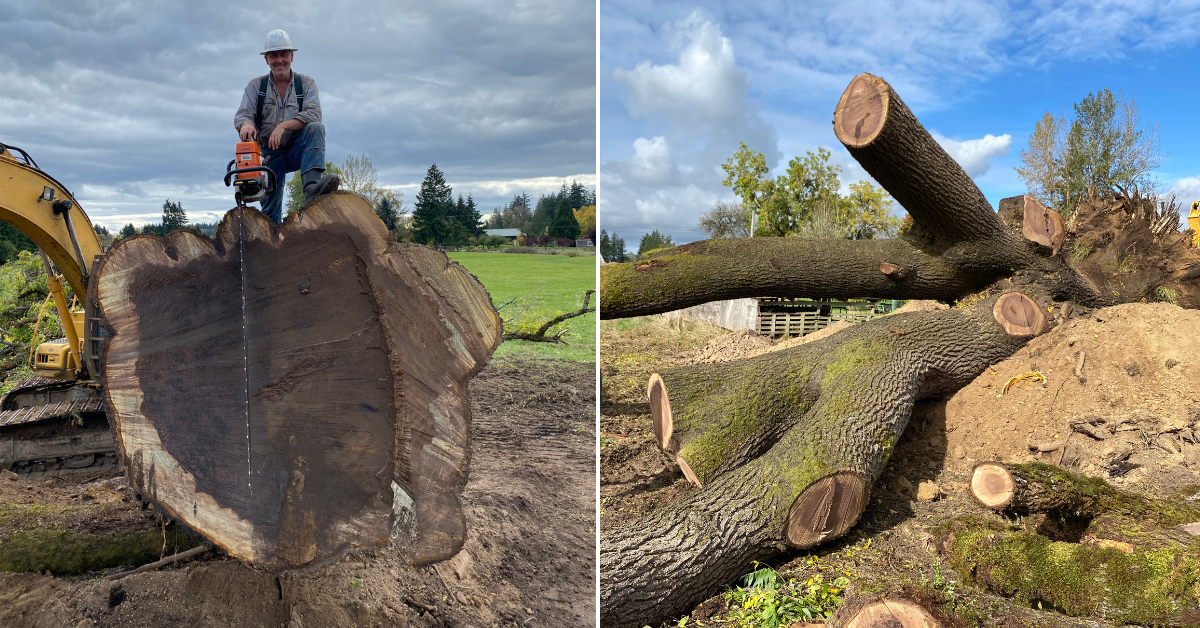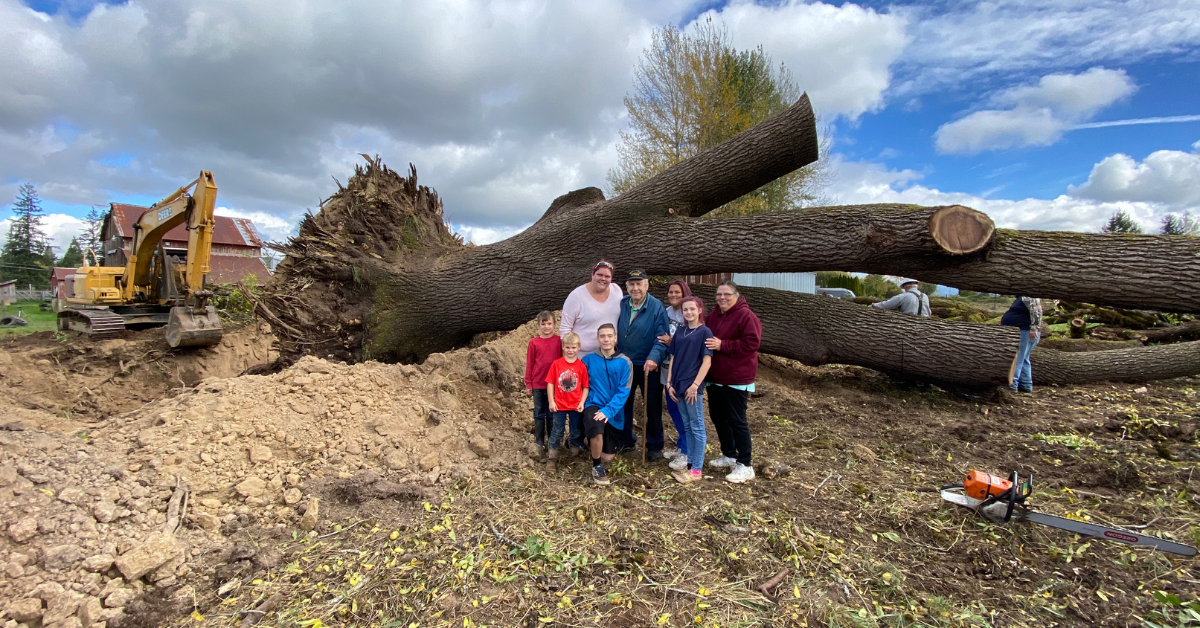A True Giving Tree
Not only are trees the largest plants on Earth, they’re also the most vital — for virtually every lifeform on the planet. They provide oxygen, store carbon, and provide life-sustaining ecosystems for animals, other plants, and, yes, humans. But the natural dependence we have on trees is often just the beginning of our connection with them.
Like people, trees tell stories, too. And when you learn to read the fascinating things they say, you realize that we often develop deep, personal connections with them. Sometimes because we’re drawn to a standout specimen or species. Other times because even a common tree can play an important, recurring role in our lives. The following story is actually a blend of the two, the tale of a beautiful Black Walnut tree that for the Winters family of Battleground, WA, grew into more than a landmark on their property — it became “The Giving Tree.”

A Quick History of the Black Walnut
Black Walnut trees thrive during cool, wet growing seasons. Which makes the Pacific Northwest an ideal region for planting and cultivating them — exactly what many of the Oregon Trail pioneers did as they migrated west between 1840 and 1860. Planting acre upon acre of Black Walnuts in western Oregon and Washington, those trailblazing settlers relied on the tree’s nuts as a food source and its wood for building materials and fuel.
Prized for its strength, grain, and easy woodworking properties, Black Walnut wood became a popular choice for gunstocks used in the Civil War. Then during World War I and World War II, the wood was used for construction, gunstocks, and airplane propellers. In fact, demand for Black Walnut was so strong, homeowners were offered substantial amounts of money for their Black Walnut trees. But those who turned down the money and nurtured their trees we’re reward even more over time — with beautiful, 150 to 200-year-old natural heirlooms.

Not Just Another Tree in the Yard
In 1972, Ray Winters and his wife moved to Battleground, WA, to start their family and build their farm. A naturally beautiful piece of property, it featured a majestic Black Walnut tree that stood more than 100 feet tall and over 8 feet in diameter. It was a true focal point on the homestead. So much so, that over time it became less of a local landmark and more a member of the family. An ever-present, silent sentinel marking time and memory for each generation. Reliably. Reassuringly. The constant in a changing world and growing family.
That’s the way it was for 50 years. Ray and his family not only admired the Black Walnut, they enjoyed it. Climbing in its branches. Playing around it. Taking naps under its canopy. Framing family pictures in front of it. And, yes, occasionally carving outlines of hearts with initials in its bark. But then, in September 2020, Ray Winters recognized the signs that his family’s old friend was nearing the end of its life. He faced a looming decision.
When Ray finally felt it was time, GL Veneer got the call to salvage and repurpose the extraordinary tree. A true honor, it’s exactly the type of opportunity we live for — not only did the Winters family trust us to help preserve a lifetime of memories in the wooden treasure the tree would become, they invited us to give the Black Walnut a second life as epic as its first.
Responsible Stewards of Nature
Ingrained in the culture of GL Veneer is the art of salvaging trees. Responsibly. Sustainably. In fact, the practice of reclaiming mostly dead or dying trees — which would normally be forgotten, burned, or left to rot — allows us to give them a second life. Preferably when they reach the end of their natural lifespans. A practice that every responsible landowner should follow, harvesting their trees just as you would a fruit or vegetable from your garden. And as there is with your garden-variety crops, there’s a more opportune time to claim your trees material before it goes to waste — and no sooner. Appropriately harvested, a tree should only be removed when it’s ready for the next leg of its journey. That’s what GL preaches, that’s what we practice.
The Winters family Black Walnut project was no exception. For a job this size, we teamed up with our good friends at Harvest Recovery Services. John Rodious, the owner of the father-son-duo company, has been milling trees his entire life. And he leans on the experience he’s honed over the decades to expertly extract these massive trees, skillfully removing the canopy and making clean cuts throughout.
Granted it takes time. On the first day of the Black Walnut project, John and his team removed the canopy and the larger limbs that would eventually be turned into smaller slabs. The next day, he dug a massive moat around the tree before easing it over — an approach that kept much of the tree intact, saving the integrity of its base, and making it much easier to remove the main limbs once the trunk was grounded.
After cutting through the bottom of the massive Black Walnut, it was time to push the base off and preserve the tree’s root. In most instances, GL saves the root ball because that’s where we often find some of the most impressive grain. But what we found when we cut the base off the Winters’ tree, surprised even us. Hidden inside this 175-year-old relic was wood of a color, grain, and stunning beauty that far exceeded anyone’s expectations — including Ray Winters and his family.
As we always do after successfully cutting off a tree’s limbs and sectioning the trunk, we cleaned up the site — restoring the family’s property back to its natural state. Then loaded everything onto our truck. And headed back to the GL Veneer headquarters, where the second phase of the reclamation project would begin.

Manufacturing the Black Walnut at GL Veneer
Back at our Huntington Park, CA, facility, it was time for the GL Veneer team to mill the different sized logs we salvaged from the Winters Black Walnut tree. At that point, we had only gotten a tiny glimpse at the wood inside the root ball. But given the quality we found there, we decided to cut all the upper limbs into slabs so we could offer all shapes and sizes the tree naturally produced. Based on the amazing wood we’d seen in the roots, our instincts proved prophetic — cut after cut, log after log, we were blown away by the color and grain of the Black Walnut wood in every piece from every section of the tree. It was perfect. Beyond anything we could have hoped for.
And it delivered more material than we could have guessed. After milling ever piece, we counted close to 25 live edge slabs, each measuring up to 15 feet long and 8 feet wide — and nearly a hundred other Black Walnut slabs of various smaller lengths. All of which are currently air-drying. With everything, including the root ball material, coming available in 2023.
So not only will the Winters family’s memories be forever preserved in the grains of this phenomenal wood, they’ll also get to celebrate it for generations to come in the new forms it takes throughout its second life. And so can you.

Coming Soon: Black Walnut Live Edge Slabs
One of North America’s most classic and iconic hardwood species, Black Walnut is drop-dead gorgeous — by any standard, for any purpose. Featuring dark, rich color tones that match almost any color scheme, the timeless wood of Black Walnut is prized for wood veneer, live edge slabs, architectural millwork, and fine furniture.
Like all trees, the exemplary Black Walnut we salvaged from the Winters property lived a long, fruitful life, and eventually died as nature intended. But as we’ve shown, it’s journey is far from over. Words can’t describe how honored we are to have played a role in transforming this one-of-a-kind Black Walnut tree. From its lifetime on the Winters family homestead to the raw material it now provides to create works of art people will cherish for generations, it truly is the “Giving Tree.”
If you are interested in reserving any of the live edge slabs from this beautiful 175-year-old piece of history, please contact us at sales@glveneer.com


